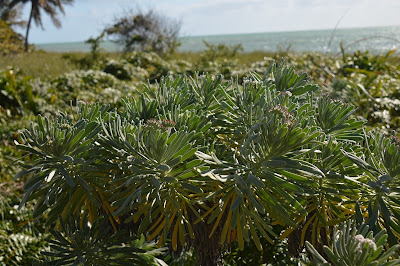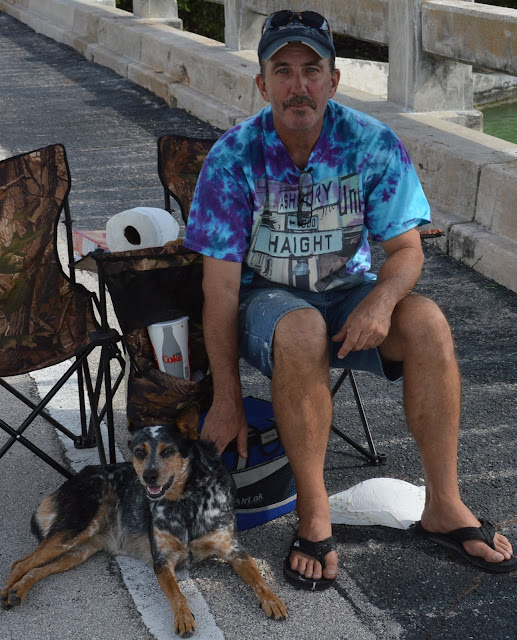The three of us set off for a morning hike on the nature trail that runs through one end of Bahia Honda State Park. There's a detailed note at the end of this post that gives you the history of this place.
Information markers on the trail identify the various plants found there and then comes the beautiful beach, the longest natural sand beach in the Keys. I plan to spend the day here at least a couple of times before we leave -- it is never very crowded because high tide completely covers the beach and what is exposed by low tide is mostly given over to wrack. Still, I found a couple of little areas that seem to stay dry and would work as a reading nook.
We pretended not to see the "no dogs on beach" sign and off we went. Elvis hates the water. He can do an impressive vertical jump when the wave rolls in over his feet. Then there were his sideways jumps . . . One of those got him trouble when he landed in a patch of nasty sticker burrs.
Fortunately he missed stepping on any of the beached Portuguese Man 'O War. Here's the skinny on this being:
The Portuguese man o’ war, (Physalia physalis) is often called a jellyfish, but is actually a species of siphonophore, a group of animals that are closely related to jellyfish. A siphonophore is unusual in that it is comprised of a colony of specialized, genetically identical individuals called zooids — clones — with various forms and functions, all working together as one. Each of the four specialized parts of a man o’ war is responsible for a specific task, such as floating, capturing prey, feeding, and reproduction. Found mostly in tropical and subtropical seas, men o' war are propelled by winds and ocean currents alone, and sometimes float in legions of 1,000 or more!
Resembling an 18th-century Portuguese warship under full sail, the man o’ war is recognized by its balloon-like float, which may be blue, violet, or pink and rises up to six inches above the waterline. Lurking below the float are long strands of tentacles and polyps that grow to an average of
30 feet and may extend by as much as
100 feet. The tentacles contain stinging nematocysts, microscopic capsules loaded with coiled, barbed tubes that deliver venom capable of paralyzing and killing small fish and crustaceans. While the man o’ war’s sting is rarely deadly to people, it packs a painful punch and causes welts on exposed skin.
This guy got a mild dose -- OUCH!
On the other end of the key is a climb that takes you to the abandoned railroad bridge and the great views available from its elevation. Turns out the UV filter fell off my lens on the walk up and by happy chance was found by a couple who recognized what it was and went looking for someone with a long lens camera -- that would be me standing on the side of the bridge rail. Nice folks from Connecticut. They asked me to use their iPhone to get some pictures of the two of them. I kept pressing the wrong white button but finally figured it out.
A selection of photos from the day follows, as does a Park Service note detailing the history of Bahia Honda Key.
Another plant to avoid. Lots of this on the island.
Then there's the Silver Palm -- it is an endangered palm and more of them are on Bahia Honda than anywhere else. I learned that a growth of palms is called a "hammock." Also learned that the coconut palm that is seen everywhere is the Keys and southern Florida is considered an invasive species, not indigenous to the area.
There are many stories of how the coconut palm arrived here. Here's one:
The wreck of the Spanish brigatine Providencia spilled 20,000 Coconuts harvested from Trinidad on the beach at present day Palm Beach on Jan. 9,1878. It was a 175 ton square rigged brig bound from Havana to Cadiz,Spain. Interestingly, all accounts suggest the weather was perfect and that the Captain and crew intentionally wrecked to collect insurance proceeds.
Beyond the Coconuts, legend has it that the ship was well provisioned with wine and other liquors. A beach party between the ragged settlers and the crew lasted two weeks.
After the party, the settlers planted these Coconuts throughout the island. The pioneers first decided to incorporate under the name of Palm City because of the incredible number of flourishing Coconuts. They found that name to already be taken so they went with their second choice, Palm Beach.
Sometime before 1893,Henry Flagler became enamored with the Island and it's multitude of Coconut palms. He began buying land and extending the railroad. But for the Coconuts, it is likely the Breaker's and other properties would not have been built by Flagler.
Is the Coconut native to Florida? When does anything become native to any place? It is certainly "naturalized".
Bill has been harvesting the coconuts on the trees in our front and back yard. He uses the coconut milk to reconstitute his orange juice and to mix with his lemonade. Then, if it is a young coconut, he eats the meat with a spoon.
We enjoyed our day and hope you enjoyed this post.
Here is the note from the Florida State Park Service that gives you an overview of the history of this park.
Bahia Honda Key's deep natural bay has long been a harbor for passing sailors. The island's name, Spanish for "deep bay," began showing up on Spanish nautical charts hundreds of years ago.
Henry Flagler’s Key West Extension of the Florida East Coast Railway arrived on the island in 1908. Of the 43 bridges needed to link mainland Florida to Key West, the Bahia Honda Bridge was one of the most difficult to construct due to the island’s namesake, which becomes a swiftly rushing channel with each change of the tides. Because of the depth of the water, the pilings to support the bridge required a massive amount of material. It took an entire boat load of sand, gravel and cement to construct one of the pilings in the center of the bridge. The railroad officially opened on January 22, 1912 and often stopped on Bahia Honda to allow passengers to enjoy the white sand beaches and picturesque blue water.
Unfortunately, Henry Flagler’s dream came to an abrupt end on Labor Day, Monday, September 2, 1935. A Category 5 hurricane, simply called the Labor Day Hurricane (the National Hurricane Service did not start naming storms until 1953), struck the Upper Florida Keys, directly hitting Islamorada with 200 mile an hour winds and a 17-foot storm surge. Miles of train track were destroyed, and the current owners of the Overseas Railroad decided to sell the Railroad and its right-of-way to the state of Florida.
Instead of repairing the train tracks, the railroad bed was covered with asphalt and converted into the Overseas Highway. The bridges were widened to accommodate two lanes of automobile traffic, but because of the narrow opening between the steel beams of the Bahia Honda Bridge, the decision was made to lay the concrete slab for cars to drive on top of the bridge instead of through it. It is a common misconception that the Bahia Honda Bridge was used by trains and cars at the same time.
The Overseas Highway opened on March 29, 1938. Originally a toll road, the Overseas Road and Toll Bridge District maintained part of the island as a public park. A gas station stood in what is now the marina area today. The park was signed over to Monroe County sometime between 1953 and 1957 and in 1961, Monroe County gave the Florida Park Service control of the park on Bahia Honda. At this time, most of the island was still owned by Monroe County and private landowners and in 1963 the County deeded an additional 63 acres to the Florida Park Service. In 1966, the state purchased 200 additional acres on the island from Monroe County to bring the park size to 292 acres, and on March 17, 1984, a private landowner sold their property at the east end of Bahia Honda to the state, bringing the entire island of Bahia Honda under the ownership of the Florida Park Service.
 Rather than spend money on a "store bought" trap for bait fish, Billy made his own. If he'd had a mentor, he would definitely have been and Eagle Scout.
Rather than spend money on a "store bought" trap for bait fish, Billy made his own. If he'd had a mentor, he would definitely have been and Eagle Scout. As noted, reading is a primary activity for me and I found the perfect outdoor place to do it -- a seat hammock partially hidden by some palms. The neighbor's house, to which it is close, are seldom here so it is a nice hide out for now.
As noted, reading is a primary activity for me and I found the perfect outdoor place to do it -- a seat hammock partially hidden by some palms. The neighbor's house, to which it is close, are seldom here so it is a nice hide out for now.











































